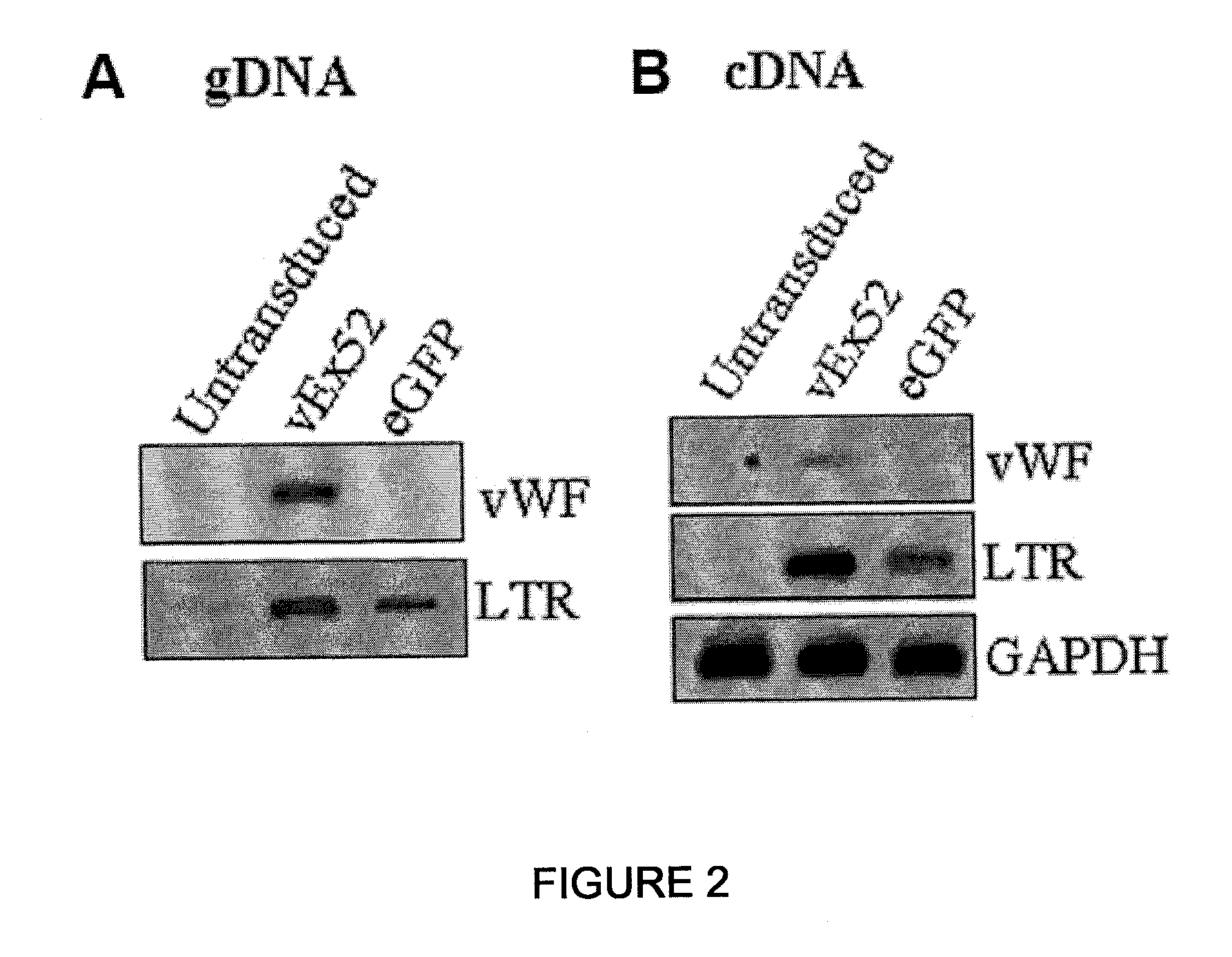Recombinant expression vector system for variants of coagulation factor VIII and von Willebrand factor
a technology expression vector system, which is applied in the field of expression vector system for variants of coagulation factor viii, can solve the problems of high risk of secondary infection, difficult to identify the origin of the virus, etc., and achieve the effect of increasing the coagulation factor viii
- Summary
- Abstract
- Description
- Claims
- Application Information
AI Technical Summary
Benefits of technology
Problems solved by technology
Method used
Image
Examples
example 1
Construction of Vectors
[0058]Plasmid pRF8 was obtained by cloning full length FVIII cDNA (ATCC Accession No. 40086) into NotI site of a modified pREP7 vector (Invitrogen, USA) using a linker. Then, in order to delete most of B-domain, the upstream 5′ region of B-domain was amplified by PCR using primers, 5′-GAACCGAAGCTGGTACCT-3′ and 5′-GACAGGAGGGGCATTAAATTGCTTTTGCCT-3′, and the downstream 3′ region was amplified using primers, 5′-TTTAATGCCCCACCAGTCTTGAAACGCCAT-3′ and 5′-ATGCTCGCCAATAAGGCATTCCA-3′. Then, the amplified products were denatured with heat and renatured to obtain the product. The resulting product was cleaved by KpnI and Bg1I and sub-cloned into KpnI-Bg1I of pRF8 plasmid to produce pREP7-BDD.FVIII in which B-domain-deleted (BDD) FVIII cDNA was inserted under the RSV 3′ LTR control of pREP7 (Invitrogen, USA) (see The Journal of Gene Medicine, Volume 6, Issue 7, Pages 760-768). We used the pREP7-BDD.FVII from Subrata Banerjee, an author of the thesis. Besides, pRex52 plasmi...
example 2
Production of Virus
[0066]Vesicular stomatitis G protein (VSV-G) pseudotyped HIV-1 was produced by cotransfecting 293T cells with gag-pol, tat, rev, VSV-G and transfer vector using quinquepartite plasmid transient transfection method (Park and Choi, 2004 Mol. Cells 17, 297-303). 293T cells were subcultured at a density of 4.5×106 cells on 100 mm plates 24 hours prior to transfection. The supernatant was replaced with culture medium comprising 10% FCS and 25 mM HEPES 4 hours prior to transfection. For transfection, packaging plasmid with Gag and Pol 10 μg, VSV-G plasmid 2 μg, Tat plasmid 1 μg, Rev plasmid 1 μg and transfer vector 10 μg were used. These DNAs were added in 62 μl of 2.5 M CaCl2, the volume was set to 500 μl with water, and vortexed. This mixture was added with 500 μg of 2×HBS (281 mM NaCl, 100 mM hepes, 1.5 mM Na2HPO4 pH 7.12), left for 30 min at room temperature, and then spread on 293T cells. 16 hours after transfection, the supernatant was replaced with RPMI of 10 mM ...
example 3
[0067]3×105 cells of NIH3T3 cells were placed on 60 cm2 dishes, and after 20 hours serial dilutions of viral stocks were added in the cells. Total volume was set to 2 ml and 2 μg / ml of polybrene (Sigma) was added. After 6 hours, the virus was removed, the cells were washed with DMEM comprising 2% FCS to remove the virus completely, and the cells were put into an incubator. After 2 days, the cells were separated with 0.25% trypsin, washed with 1×PBS, and fixed with 3.7% formaldehyde. Percent of eGFP+ radiating in the infected cells was determined using FACScan (Becton Dickinson Immunocytometry System) and CellQuest program (Becton Dickinson), and then the titer of virus was calculated using the following formula: (2×a number of cells×Percent of eGFP+ cells)÷quantity of virus.
PUM
 Login to View More
Login to View More Abstract
Description
Claims
Application Information
 Login to View More
Login to View More - R&D
- Intellectual Property
- Life Sciences
- Materials
- Tech Scout
- Unparalleled Data Quality
- Higher Quality Content
- 60% Fewer Hallucinations
Browse by: Latest US Patents, China's latest patents, Technical Efficacy Thesaurus, Application Domain, Technology Topic, Popular Technical Reports.
© 2025 PatSnap. All rights reserved.Legal|Privacy policy|Modern Slavery Act Transparency Statement|Sitemap|About US| Contact US: help@patsnap.com



